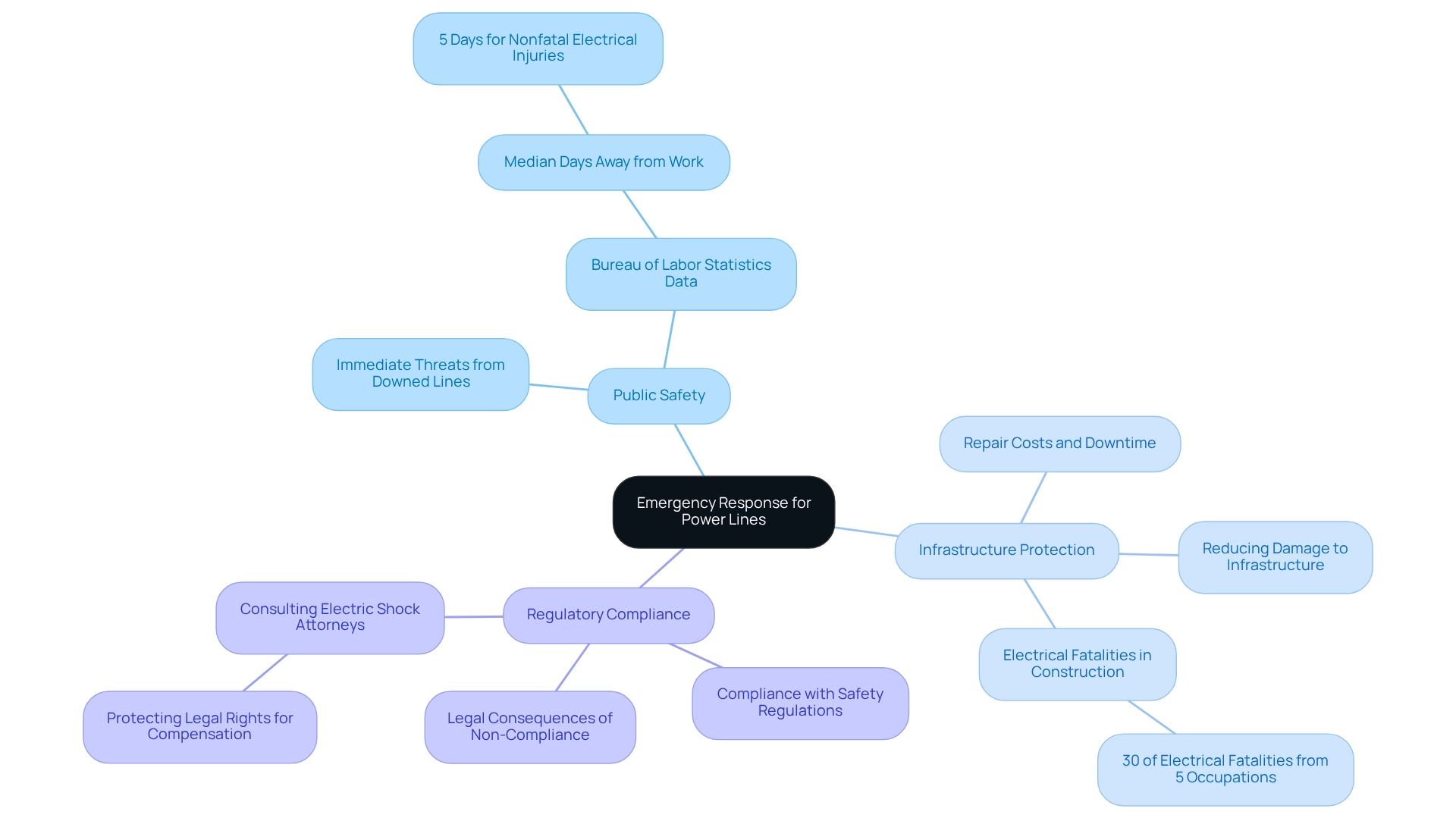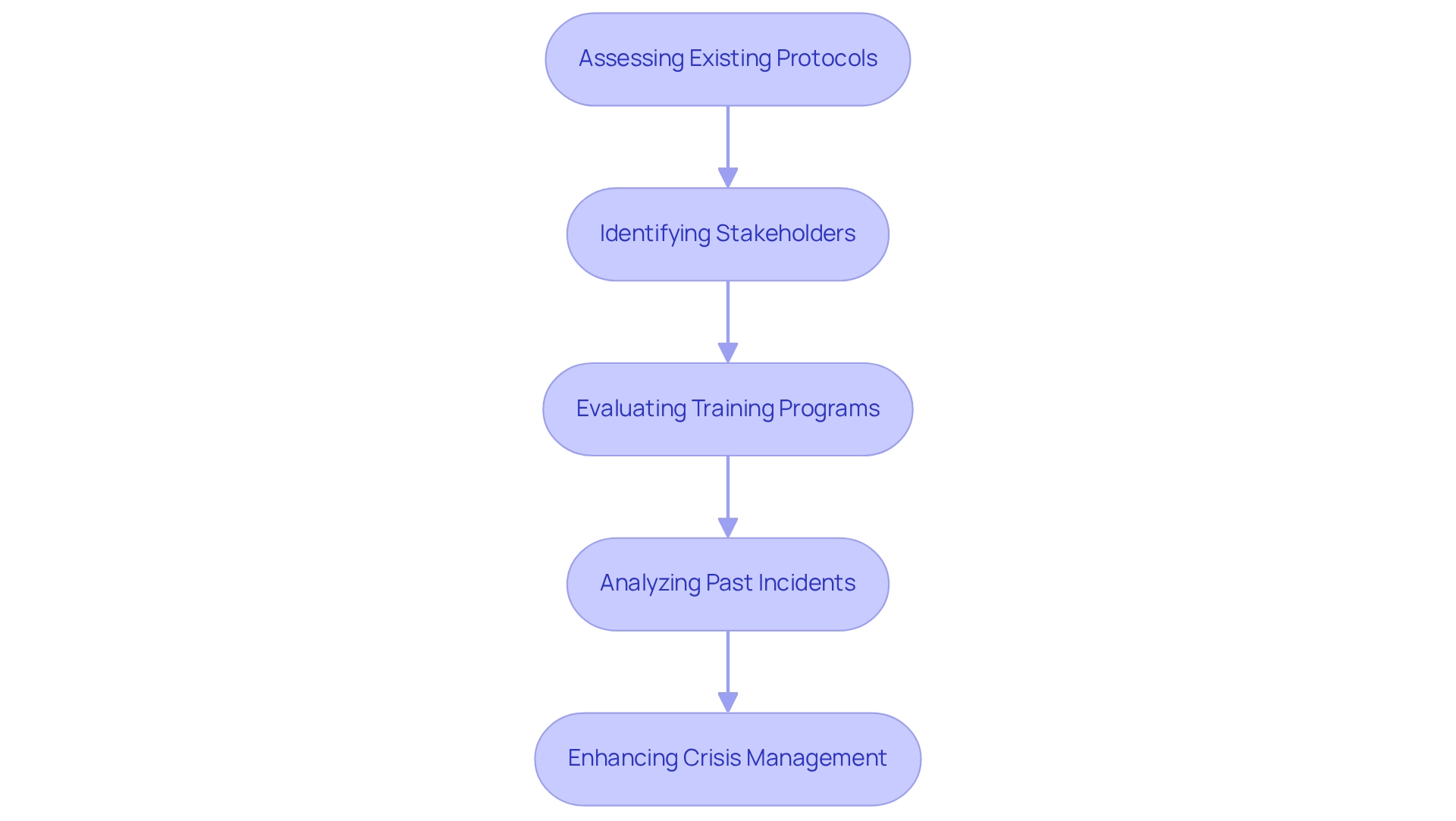Overview
The article presents four crucial steps for effective emergency response concerning power lines, underscoring the significance of:
- Public safety
- Infrastructure protection
- Regulatory compliance
- Stakeholder engagement
It delineates a systematic approach that begins with assessing existing protocols, progresses to developing tailored response plans, and culminates in the active involvement of all relevant stakeholders. This comprehensive strategy ensures preparedness and facilitates swift action during electrical emergencies.
Introduction
In an era where electricity underpins nearly every facet of daily existence, the safety and reliability of power lines assume critical importance. The potential dangers presented by downed or damaged lines can lead to severe consequences, underscoring the necessity for effective emergency response strategies to safeguard public safety and infrastructure.
This article explores the essential elements of emergency response planning, from evaluating existing frameworks to engaging stakeholders, ultimately offering a comprehensive roadmap for organizations to bolster their preparedness and response capabilities.
By grasping the complexities of these strategies, stakeholders can ensure a prompt and coordinated approach to managing power line incidents, thereby protecting lives and minimizing disruptions.
Understand the Importance of Emergency Response for Power Lines
The imperative nature of emergency response for power lines arises from the serious risks posed by fallen or damaged wires, which can transmit high-voltage electricity, leading to severe injuries or fatalities if not managed properly. Swift action is crucial for effective emergency response for power lines to prevent accidents and ensure public safety. Key considerations include:
- Public Safety: Downed power lines pose immediate threats to individuals nearby. Understanding these risks is vital for developing effective emergency response for power lines strategies. Recent data from the Bureau of Labor Statistics reveals that the median number of days away from work for nonfatal electrical injuries is five, underscoring the urgency for prompt action.
- Infrastructure Protection: Quick responses can significantly reduce damage to infrastructure, thereby lowering repair costs and minimizing downtime. The Electrical Safety Foundation International reports that five occupations in construction account for 30% of all electrical fatalities, highlighting the necessity for targeted safety measures in these roles to prevent such incidents.
- Regulatory Compliance: Utility companies must comply with safety regulations and protocols to avoid legal consequences and maintain public trust. Consulting with knowledgeable electric shock attorneys can help safeguard legal rights for compensation in case of incidents, emphasizing the importance of having a well-organized action plan.
By recognizing these critical aspects, stakeholders can better understand the significance of an organized crisis management plan for emergency response for power lines, ultimately enhancing public safety and operational effectiveness.

Assess Existing Emergency Response Frameworks
To effectively manage crises associated with electrical cables, organizations must conduct a thorough evaluation of their current emergency response for power lines. This essential process encompasses several critical steps:
- Assessing Existing Protocols: Organizations should meticulously analyze their emergency action plans, focusing on procedures for addressing fallen electrical cables. This review is vital for identifying gaps and areas requiring enhancement, particularly in relation to emergency response for power lines, given that the nation's electric transmission and distribution systems span millions of miles.
- Identifying Stakeholders: Mapping out all parties involved in the response process is crucial. This includes utility providers, emergency services, local authorities, and community organizations, ensuring a coordinated effort during incidents.
- Evaluating Training Programs: Assessing the training provided to emergency personnel is imperative. Organizations must ensure that staff are equipped with the necessary skills and knowledge to handle crises effectively. Research indicates that comprehensive training programs significantly improve response times and outcomes. Additionally, organizations can leverage crisis management programs and playbooks from the EEI to enhance their training initiatives.
- Analyzing Past Incidents: Reviewing previous emergency actions can provide valuable insights. By analyzing successful strategies and those that fell short, organizations can refine their protocols and bolster future responses. Prioritizing the needs of marginalized communities in disaster management is particularly important, as these groups often face unique challenges. Case studies have shown that investing in training, education, and technology enhances disaster preparedness and management capabilities, especially for these communities.
By systematically evaluating these areas, organizations can uncover opportunities for improvement, ultimately enhancing their crisis management capabilities and ensuring more effective handling of utility incidents, particularly in emergency response for power lines.

Develop a Tailored Emergency Response Plan
Developing a tailored emergency response for power lines is essential for ensuring preparedness and effective management during incidents. This process involves several critical steps:
- Define Objectives: Establish clear goals for the crisis response plan, focusing on minimizing risks to personnel and ensuring swift energy restoration. For example, objectives might include reducing outage times by a specific percentage or ensuring the safety of first responders. Statistics demonstrate that proactive strategies can significantly minimize outage times, reinforcing the necessity of well-defined objectives.
- Establish Protocols: Develop detailed procedures for addressing downed power lines, incorporating communication strategies and safety measures. This ensures that all team members are aware of their roles and responsibilities during an emergency.
- Allocate Resources: Identify and allocate essential resources, such as personnel, equipment, and technology, to support recovery efforts. This may involve ensuring that backup power sources and communication tools are readily available.
- Implement Training: Conduct thorough instruction for all parties involved on the crisis management plan. This should encompass simulations and drills, allowing teams to practice procedures and enhancing their readiness for real-life scenarios. As Ronald Reagan once said, "The greatest leader is not necessarily the one who does the greatest things. He is the one that gets people to do the greatest things," emphasizing the importance of effective leadership in training.
- Regularly Update the Plan: Continuously review and refine the contingency plan based on new information, technological advancements, and insights gained from past incidents. Regular updates are crucial for maintaining the plan's effectiveness and relevance. For instance, the case study titled "Accommodating Remote Work During Outages" illustrates how companies can sustain operations during electrical interruptions by providing staff with laptops and IT safeguards, thereby reducing disruptions.
By following these steps, organizations can create a robust plan for emergency response for power lines tailored to their unique needs, ultimately enhancing their capacity to handle line incidents efficiently. Proactive approaches, including regular drills, are vital for ensuring that businesses are prepared to manage outages effectively. Furthermore, during crises, collaboration with governmental allies, as demonstrated in the methods of the EEI, is essential for restoring energy and addressing risks to critical infrastructure.

Engage Stakeholders for Effective Implementation
Involving stakeholders is vital for the effective execution of an emergency response for power lines. This can be achieved through several key strategies:
- Identifying Key Stakeholders: Recognize essential participants in crisis management, including utility companies, local government agencies, urgent services, and community organizations. Understanding their roles ensures a coordinated effort during crises.
- Facilitating Communication: Establish strong communication channels to ensure that all stakeholders receive timely updates and can share essential information during crises. Effective communication is vital; statistics indicate that 59% of organizations faced at least one ransomware attack last year, highlighting the need for secure and reliable information sharing. Additionally, about 58% of backups fail during recovery, underscoring the importance of dependable communication systems.
- Conducting Workshops and Training: Arrange workshops and training sessions to educate stakeholders about their particular roles and duties within the crisis management framework. This proactive strategy promotes readiness and improves the overall efficiency of the action plan.
- Building Connections: Foster robust relationships among stakeholders to encourage cooperation and trust, which are crucial during crises. As John Quincy Adams expressed, motivating others is the hallmark of a leader; nurturing these connections can greatly enhance reaction times and resource distribution.
- Collecting Input: Consistently request feedback from stakeholders to improve the crisis management plan and resolve any issues. Ongoing enhancement driven by stakeholder feedback is essential for upholding an effective strategy.
By actively involving stakeholders, organizations can create a more unified and efficient strategy for crises, ultimately improving safety and operational resilience during the emergency response for power lines. As Tracy Rock noted, the importance of communication in emergency response cannot be overstated; it is critical for ensuring that all parties are informed and prepared.

Conclusion
The significance of effective emergency response for power lines is paramount. This article delineates the essential elements required to protect public safety and infrastructure from the hazards associated with downed or damaged lines. By prioritizing public safety, infrastructure protection, and regulatory compliance, stakeholders can grasp the urgency of implementing a well-structured emergency response plan.
Assessing existing frameworks is critical for identifying gaps and improving response capabilities. Organizations must thoroughly review current protocols, engage stakeholders, evaluate training programs, and analyze past incidents to refine their approaches. A customized emergency response plan, grounded in clear objectives and established protocols, is vital for minimizing risks and ensuring swift recovery during power line emergencies.
Engaging stakeholders through effective communication, workshops, and relationship-building cultivates a collaborative environment that enhances the overall efficacy of emergency responses. By actively involving all parties in the planning and execution of these strategies, organizations can bolster their preparedness and resilience against potential power line incidents.
In conclusion, a proactive and coordinated approach to emergency response for power lines not only safeguards lives but also ensures the continuity of essential services. As communities confront increasing challenges from electrical incidents, investing in comprehensive emergency response strategies will be instrumental in protecting both individuals and infrastructure, paving the way for a more secure future.
Frequently Asked Questions
Why is emergency response for power lines important?
Emergency response for power lines is crucial due to the serious risks posed by fallen or damaged wires that can transmit high-voltage electricity, leading to severe injuries or fatalities if not managed properly. Swift action is essential to prevent accidents and ensure public safety.
What immediate threats do downed power lines pose?
Downed power lines pose immediate threats to individuals nearby, making it vital to understand these risks for developing effective emergency response strategies.
What does recent data indicate about electrical injuries?
Recent data from the Bureau of Labor Statistics indicates that the median number of days away from work for nonfatal electrical injuries is five, highlighting the urgency for prompt action in emergency situations.
How does quick response impact infrastructure during power line emergencies?
Quick responses can significantly reduce damage to infrastructure, lowering repair costs and minimizing downtime.
What percentage of electrical fatalities in construction is accounted for by five specific occupations?
Five occupations in construction account for 30% of all electrical fatalities, underscoring the necessity for targeted safety measures in these roles.
Why is regulatory compliance important for utility companies?
Utility companies must comply with safety regulations and protocols to avoid legal consequences and maintain public trust.
How can consulting with electric shock attorneys help in power line incidents?
Consulting with knowledgeable electric shock attorneys can help safeguard legal rights for compensation in case of incidents, emphasizing the importance of having a well-organized action plan.
What is the overall significance of an organized crisis management plan for power lines?
Recognizing the critical aspects of emergency response for power lines helps stakeholders understand the significance of an organized crisis management plan, ultimately enhancing public safety and operational effectiveness.
List of Sources
- Understand the Importance of Emergency Response for Power Lines
- Workplace Injury & Fatality Statistics - Electrical Safety Foundation International (https://esfi.org/workplace-safety/workplace-injury-fatality-statistics)
- Electrical Accident Statistics: What You Need To Know (https://electrocuted.com/electrical-safety/electrical-accident-statistics)
- Assess Existing Emergency Response Frameworks
- Reliability & Emergency Response (https://eei.org/issues-and-policy/reliability-emergency-response)
- Emergency Management by Statistics: for Resilient Future (https://profiletree.com/emergency-management-by-statistics)
- Develop a Tailored Emergency Response Plan
- 50 Quotes on Crisis Management & Leadership that Will Make You Think (https://ewweb.com/home/article/21127954/50-quotes-on-crisis-management-leadership-that-will-make-you-think)
- 7-Step Power Outage Emergency Response Plan [+ Template] (https://alertmedia.com/blog/power-outage-emergency-response-plan)
- Reliability & Emergency Response (https://eei.org/issues-and-policy/reliability-emergency-response)
- Engage Stakeholders for Effective Implementation
- 25 Disaster Recovery Statistics That Prove Every Business Needs a Plan (https://invenioit.com/continuity/disaster-recovery-statistics?srsltid=AfmBOooZ9HHYKExo1FXENa0znoy3J_HOpFAWaUBHrGv9Eahx6K8vVWsM)
- 50 Quotes on Crisis Management & Leadership that Will Make You Think (https://ewweb.com/home/article/21127954/50-quotes-on-crisis-management-leadership-that-will-make-you-think)




